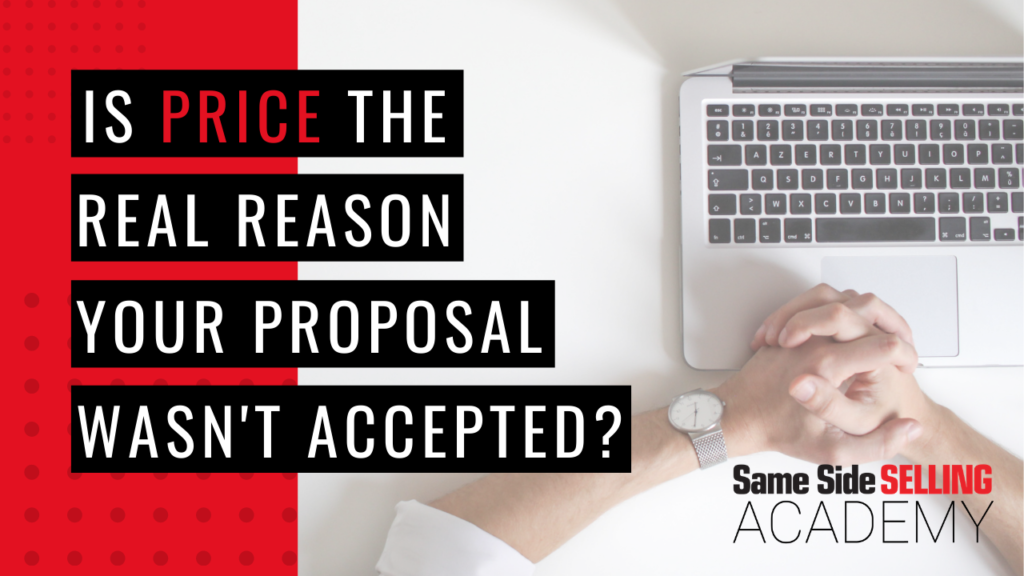A question I’m often asked is, “What do we do when a customer comes back saying that we were not selected because our price was too high?”
It’s fairly common for clients to cite price as a reason for picking one vendor over another, but what you may not realize is that, more often than not, price isn’t the real reason you weren’t selected.
It’s helpful to know the actual reason why you weren’t chosen so that you can make tweaks and changes to your approach, offer, or the way you are setting yourself apart from the competition.
This is why the first thing you should do is investigate what the client really might mean when they say, “Your price is too high.”

I find that there are two common scenarios that most clients fall into when citing price as the reason for not choosing a vendor.
The first is that your business might actually provide the same thing as another vendor, but for a higher price. However, it’s important to realize that rarely does a competitor offer the exact same thing that you do. Unless you are selling a drop-shipped commodity there should always be a way to differentiate yourself.
If you are consistently running into this problem, look for ways to separate your business from others. Think about what problems you solve, rather than what you’re selling, and find ways to describe the value your business adds by solving these problems at a high level. Set yourself apart from the competition by telling success stories from other clients who had similar problems. Examine what the competition is really offering, and change your approach to address the differences upfront.
Another reason you may find a client telling you that your price is too high is that they are simply trying to be polite. They think that telling you that your price is too high is kinder than telling you the real reason they didn’t go with you.
Imagine it like this: Your company has a new project and several vendors bid on the project, including your friend’s company. Your friend’s presentation was horrible and so the selection committee chooses another vendor. When your friend asks you why your company went with someone else, you’re probably tempted to tell them it was because their price was higher than the competitors rather than telling them their presentation was terrible.
It feels better as the seller to say that you were undercut rather than outsold, but it won’t help you to make the improvements that will help you make the sale the next time.
After I’ve explained these two scenarios I’m usually asked, “But what if it really is about price?” I promise that it is almost never about price!
But, if it is, here is what most likely went wrong - you focused on what you were selling, rather than on what problems the client needed to solve. You didn’t ask the right questions, you didn’t engage the client in a discussion about past experiences, and you didn’t share stories of other clients with similar issues whose problem you helped to solve.
It is usually the seller who frames the discussion about price. You may ask your potential client how much they are paying their current provider. A natural follow-up would be to say, “Maybe we can get you a better deal.”
What if instead, you asked the client something like, “On a scale of zero to 10 how happy are you with your current provider?” This allows you to either provide a better outcome, or a better price.
If it’s a bidding situation you might be thinking that this won’t work since you don’t have access to the client ahead of time. Think back to the last time your organization was making a purchase using a bidding process. Did each member of your team have a vendor that they hoped would win? Of course! Your customers do too.
So before you enter into one of these situations, ask yourself what percentage of deals you win without discussing the project with the client ahead of time. If the number is less than 10% then decide against bidding on those projects unless you can find a way to speak with the client first. If you think your number is more than 10%, then you might not be estimating accurately. In most cases, companies win less than 5% of deals they engage in before they interact with the customer.
To improve your odds, fight for the chance to communicate with all your potential clients before bidding. You can’t provide quality advice to them unless you have the complete picture and the chance to obtain any needed additional information. It’s in the best interest of both parties that you have the opportunity to ask thoughtful questions and determine if their situation is a fit for what you offer.
The most important thing to do after that is to make an honest assessment. You might find that you are not the right fit for them and that it would be in their best interest to use an alternative solution.
If this happens, be honest and upfront. Let them know by saying something like, “In this situation, we may not be the best fit. Would you be upset if we declined to bid?” This level of honesty will differentiate you and you might be surprised at how quickly you are invited to bid on the next new project.
You’ll be demonstrating that you are always looking out for the client’s best interest and that finding the right fit is more important than making the sale. If you do this right, you’ll become the vendor they are all rooting for.
Tell me about a time you focused on your client’s best interest, rather than on making a sale. How did the client react and what long-term benefits did you see?



You must be logged in if you want to submit a suggestion.